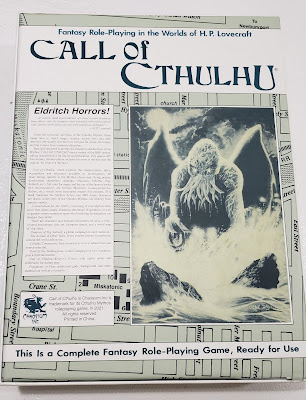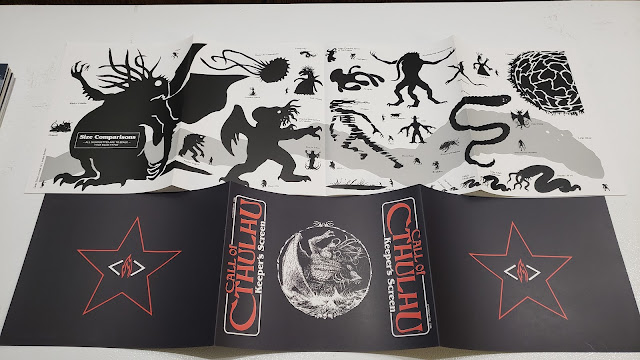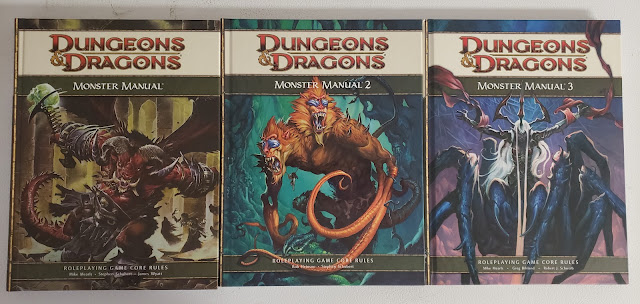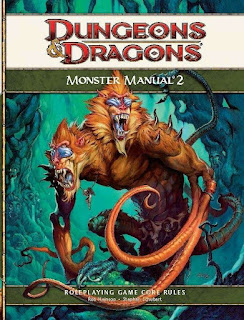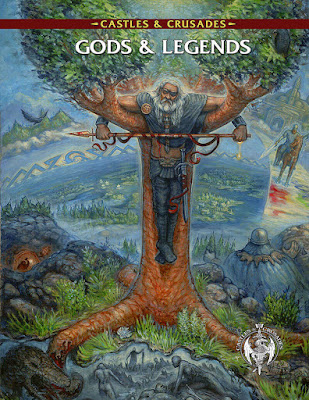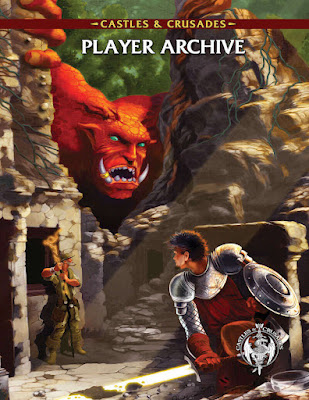Solitaire: Tome of Terror: Transylvania
 What marks Tome of Terror: Transylvania—as well as the rest of The StoryMaster’s Tales series—as being different is that it a solo adventure book best played by more than one player and that each and every scene in its story contains a QR code. Scan this and click on the link and the reader will automatically be taken to the narration for the location, which provides a description, some possible actions, and some suitably ominous music. It certainly ups the atmosphere as the stalwart heroes set out to investigate tales of vampires, werewolves, ghosts, and other monsters in the lands of Transylvania and the castle itself. It consists of some fifty locations, comes with four pre-generated Investigators, a means for a player to create his own, maps—some blanks so that the adventures can be played again, a list of potential rewards, and its own neat twist on the dice on the page flipping mechanic. Tome of Terror: Transylvania is inspired by the classics of the genre such as Dracula and Frankenstein, as well as the Hammer Horror films, and so takes place sometime in the nineteenth century.
What marks Tome of Terror: Transylvania—as well as the rest of The StoryMaster’s Tales series—as being different is that it a solo adventure book best played by more than one player and that each and every scene in its story contains a QR code. Scan this and click on the link and the reader will automatically be taken to the narration for the location, which provides a description, some possible actions, and some suitably ominous music. It certainly ups the atmosphere as the stalwart heroes set out to investigate tales of vampires, werewolves, ghosts, and other monsters in the lands of Transylvania and the castle itself. It consists of some fifty locations, comes with four pre-generated Investigators, a means for a player to create his own, maps—some blanks so that the adventures can be played again, a list of potential rewards, and its own neat twist on the dice on the page flipping mechanic. Tome of Terror: Transylvania is inspired by the classics of the genre such as Dracula and Frankenstein, as well as the Hammer Horror films, and so takes place sometime in the nineteenth century.Published by StoryMaster’s Tales, Tome of Terror: Transylvania is intended to be played by between one and five players—preferably the latter—aged seven and over. Given its subject matter and the text-heavy format, with younger players, more mature players will be required to play alongside them, perhaps with an adult as StoryMaster. Thus, Tome of Terror: Transylvania can be played as a family game.
An Investigator in Tome of Terror: Transylvania has a Name, Occupation—either Author, Explorer, Priest, and Professor, and several attributes. These include Fighting Skill, Supernatural Insight, Fortune, Study Level, Reflex, Health, and LEU. Of these, LEU is a currency which can be spent during the Investigators’ enquires; Reflex is his dexterity; Study Level is his concentration and curiosity; Fortune his luck; Supernatural Sight his capacity to see and face the forces of the unnatural. Alternatively, a player can create his own. If he does so, he sets his Health at ten and Fortune at four, and then divides ten points between Fighting Skill, Supernatural Insight, Study Level, and Reflex. LEU is also randomly determined. He is also free to decide upon his Investigator’s Occupation rather than adhere to those of the given four. These four include a priest drawn to investigate the supernatural, an authoress in search of authentic background for her next novel, a professor in search of an old student—one Victor Frankenstein, and an explorer in search of the strange, the exotic, and adventure.
Mechanically, Tome of Terror: Transylvania uses a four-sided die and a six-sided die. It does not use a simple type of roll, varying depending upon the situation. Sometimes a player will be asked to roll equal to or under a given attribute on a six-sided die. Combat though, requires a player to roll a six-sided die and add his Fighting Skill, the aim to roll higher than the opposing roll made by the StoryMaster. Whomever loses the roll also loses a point of Health and if the latter is reduced to zero, the combatant is dead. Weapons add to a combatant’s Fighting Skill. When fighting against supernatural creatures, a player adds his Investigator’s Fighting Skill and Supernatural Insight to get his attack total. Group attacks, whether by the Investigators co-operating together or the Investigators and their companions, are done with everyone taking it in turns to attack. Lastly, if the Investigators want to flee a fight, then they can do so, but will lose a point of Health in the process. At other times, a four-sided die is rolled to determine a random outcome and Fortune can be gained and lost throughout the story. So simple enough, but not immediately obvious or easy to grasp, although it is clear that the author is trying to make Tome of Terror: Transylvania easy to run.
Alternatively, an eight-sided die and a ten-sided die can be used instead of the four-sided die and the six-sided die if the players want to make Tome of Terror: Transylvania more challenging. If the players lack dice, a player can instead flick through the pages with his thumb and when he stops at a page, the numbers on the dice immediately above where his thumb is on the page, those are his die results. There are seven combinations of four-sided dice and six-sided dice on each and every page, which provides numerous combinations and plenty of random results.
So how does Tome of Terror: Transylvania play? Although it can be played solo, it is really designed to be played by five participants, one of whom takes the role of the StoryMaster. Essentially then, he takes the role of the Game Master. The other players take the role of the Investigators. Then everyone picks a Tale from the four included in the book. These are ‘Horror of the Vampire’, ‘Mark of the Werewolf’, ‘Curse of Frankenstein’, and ‘Spirits of the Dead’. Each of these presents the players and their Investigators with an objective and a reward, and after this is read out, the story proper begins at the Tavern. Each of the fifty entries in Tome of Terror: Transylvania is several pages long, varying in length between two and six pages. Each has its own illustration, introduction in bold (which matches that of its narration) and then four options. For example, “Ask for something to drink”, “See what there is to eat”, “Talk to a local”, and “Search the tavern”. Each of the four entries is then greatly expanded depending upon what the Investigators are attempting to do. The players are free to choose which options they want, though no more than two options chosen per encounter. The combination of this and the multiple tales means that the Tome of Terror: Transylvania can be played more than once.
Of course, Tome of Terror: Transylvania is intended to be dramatic, and the author actually performs many of these tales as the StoryMaster. The StoryMaster in Tome of Terror: Transylvania is encouraged to make the ending of each tale as dramatic as possible, to put on a performance, and to be fair, a certain degree of performance is required, since there is a lot of text to go through and present.
Physically, Tome of Terror: Transylvania starts poorly, but gets better. The initial explanation and set-up, and the explanation of rules, could all be more clearly presented for ease of play. However, once the tale starts, the writing improves as the author is clearly enjoying himself. The artwork and the maps are all good, and like the writing, the layout of the various entries is far better than that of the first part of the book.
Mechanically, Tome of Terror: Transylvania is simple, but as simple as the rules are, they are also messy and could have been more consistent. Put that aside, they are simple enough to use and they are simple to impart to players not used to roleplaying. Where Tome of Terror: Transylvania shines is in the tales themselves and the exploration of Transylvania and the revelation of its horrors. Unlike other solo adventure books, Tome of Terror: Transylvania really deserves a participating audience and a Storymaster who can ham it up!





